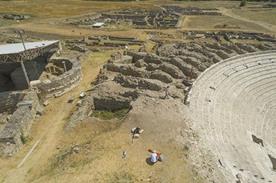
This year’s season of the project for conservation, restoration, reconstruction and archeological research of the Roman theatre at Stobi took place between June and November. The work was focused on three points: conservation of the marble elements of the scene building, conservation and restoration of the supporting walls under the seats from the upper segment of the auditorium (summa cavea) and archaeological excavations of the west parodos.
The conservation process of the marble elements of the scene building included in situ cleaning and consolidation of the podium blocks and stairways of the scaenae frons. Namely, this part of the scene building had never been the subject of conservation and it was in a critical condition. The stone conservator of NI Stobi, Mariana Filova, successfully returned the original glow of the marble blocks and prevented the further deterioration. The conservation of the scene building will continue next season and the completion will open the opportunity for anastylosis i.e. re-assembly of the columns and the rest of the architectural elements which comprised the most elaborate decorative part of the theatre.
The massive walls of the substructure under the seats from the upper segment of the auditorium are exposed up to 6 metres in some locations, suggesting high level of preservation of the building. However, the upper zones of the walls, to the height of around 2 metres, are continuously disintegrating. In 2020, the NI Stobi began the conservation of the walls in the eastern half with the restoration treatment of eight radial walls out of the sixteen exposed. The conservation project in this segment of the theatre was led by Professor Trajche Nacev.
The archaeological excavations of the west parodos i.e. the west open corridor between the auditorium and the scene building were focused on complete exposure of the area which was the subject of excavations in the 1990s. The team of archaeologists discovered ruins from the walls of the theatre which collapsed as the result of the earthquake from around 300 CE. After the earthquake, the theatre was repaired, the destruction in the west parodos was covered and a new floor level was established on top. The floor had series of holes for wooden posts with unclear purpose. The explanation is more complicated as the area was divided in length by the construction of a wall in the last functional years of the theatre.
The project season of 2020 had a total budget of 3 500 000 denari (57 000 EU), completely funded by the Ministry of Culture through the annual program for cultural projects of national interest. The plan for the project in 2021 involves completion of the conservation of the scene building, restoration of the remaining walls and stairways in the upper segment of the auditorium, and archaeological excavations between the radial wall in order to document the levels of use and understand the system for circulation of the audience. Click here for gallery.